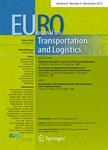版权所有:内蒙古大学图书馆 技术提供:维普资讯• 智图
内蒙古自治区呼和浩特市赛罕区大学西街235号 邮编: 010021

作者机构:Polytech Montreal 2500 Chemin Polytech Montreal PQ H3T 1J4 Canada Univ Quebec Montreal Sch Management 315 Rue St Catherine Est Montreal PQ H2X 3X2 Canada Ctr Interuniv Rech Reseaux Entreprise Logist & Tra 2920 Chemin Tour Montreal PQ H3T 1J4 Canada Canada Excellence Res Chair Data Sci Real time Dec 2500 Chemin Polytech Montreal PQ H3T 1J4 Canada Grp Etud & Rech Anal decis GERAD 2920 Chemin Tour Montreal PQ H3T 1N8 Canada
出 版 物:《EURO JOURNAL ON TRANSPORTATION AND LOGISTICS》 (EURO J. Transp. Logist.)
年 卷 期:2024年第13卷
核心收录:
学科分类:1201[管理学-管理科学与工程(可授管理学、工学学位)] 08[工学] 0823[工学-交通运输工程]
基 金:Natural Sciences and Engineering Research Council (NSERC) of Canada [2023-04466, 2017-05224] Fonds de Recherche du Quebec-Nature et Technologie (FRQNT)
主 题:Bike-sharing systems Dynamic rebalancing Inventory intervals Target inventories Reoptimization modes Mixed-integer programming
摘 要:Bike-sharing systems have become a popular transportation alternative. Unfortunately, station networks are often unbalanced, with some stations being empty, while others being congested. Given the complexity of the underlying planning problems to rebalance station inventories via trucks, many mathematical optimizations models have been proposed, mostly focusing on minimizing the unmet demand. This work explores the benefits of two alternative objectives, which minimize the deviation from an inventory interval and a target inventory, respectively. While the concepts of inventory intervals and targets better fit the planning practices of many system operators, they also naturally introduce a buffer into the station inventory, therefore better responding to stochastic demand fluctuations. We report on extensive computational experiments, evaluating the entire pipeline required for an automatized and data-driven rebalancing process: the use of synthetic and real-world data that relies on varying weather conditions, the prediction of demand and the computation of inventory intervals and targets, different reoptimization modes throughout the planning horizon, and an evaluation within a fine-grained simulator. Results allow for unanimous conclusions, indicating that the proposed approaches reduce unmet demand by up to 34% over classical models.